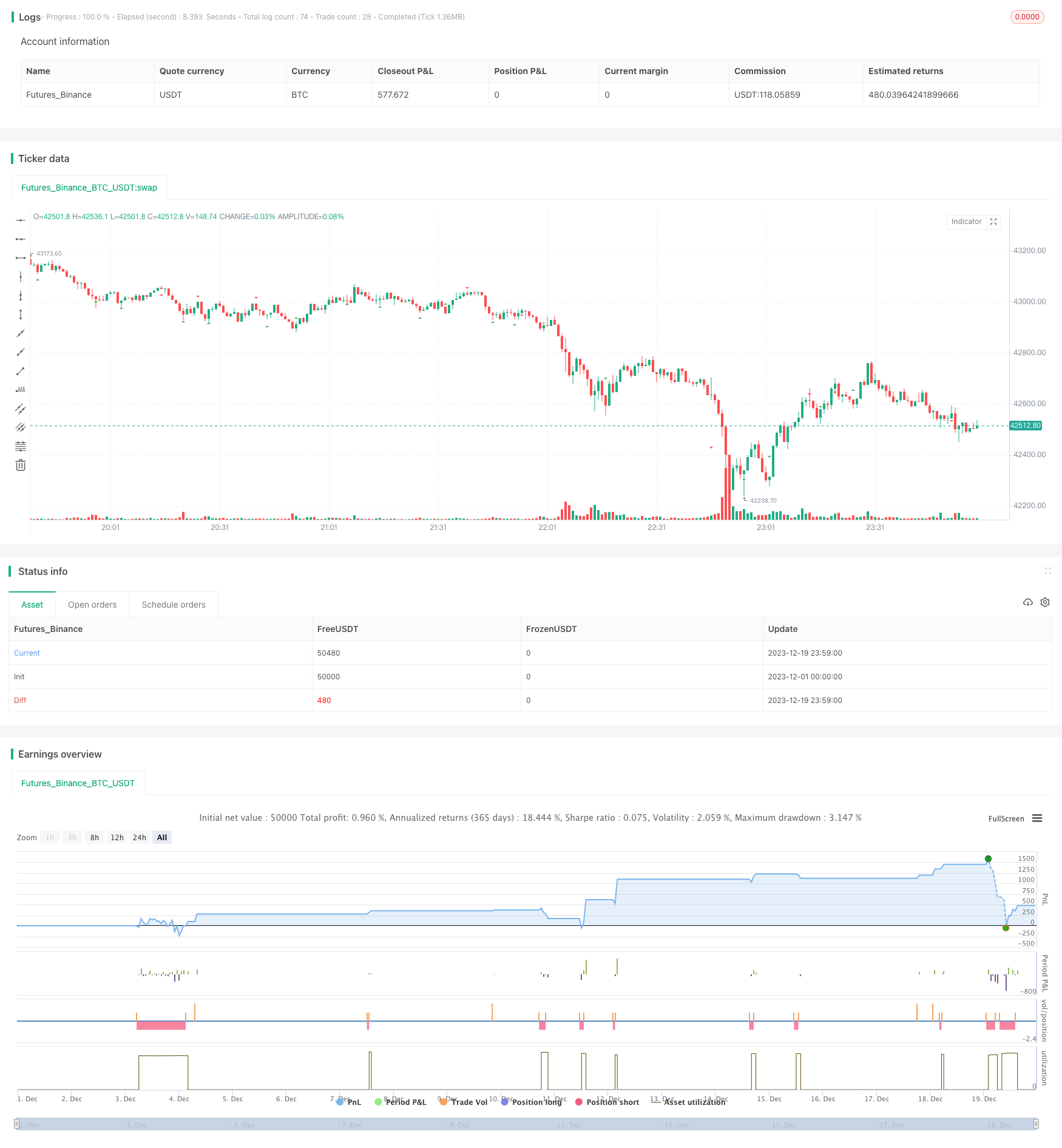
概述
该策略基于枢轴点和斐波那契回撤比率自动识别股价的ABC波段,并给出长短仓信号。策略利用枢轴点判断股价波段,然后计算ABC波段之间的斐波那契回撤比例,如果符合一定条件就产生交易信号。
策略原理
- 计算股票的枢轴高点和低点
- 判断价格是否从上一波段高点下落或从上一波段低点上涨
- 计算当前波段与上一波段之间的斐波那契回撤比例
- 如果上涨波段和下跌波段的回撤比例都在适当范围内,则判定可能形成ABC波段
- 在ABC波段确认后,做多时设置止损为C点位,止盈为1.5倍波动;做空时设置止损为A点位,止盈为1.5倍波动
优势分析
- 利用枢轴点判断关键支撑阻力区域,提高信号准确率
- 应用斐波那契回撤识别ABC形态,自动捕捉趋势转换点
- 止盈止损清晰合理,避免出现巨大亏损
风险分析
- 枢轴点和斐波那契回撤并不能保证每次都精确判断趋势转换点,可能出现误判
- C点和A点止损可能被突破,造成损失扩大
- 需要参数优化,比如斐波那契回撤比率的范围
优化方向
- 可以结合更多技术指标辅助判断ABC形态,提高信号准确率
- 可以优化斐波那契回撤比率的范围,以适应更多市场情况
- 可以结合机器学习方法训练判断ABC形态的模型
总结
该策略基于枢轴点判断关键支撑阻力区域,并利用斐波那契回撤比例自动识别ABC形态,在波段转折点给出长短仓交易信号。策略逻辑清晰简洁,止盈止损设置合理,能够有效控制风险。但是也存在一定误判风险,需要进一步优化和改进以适应更多市场情况。
策略源码
/*backtest
start: 2023-12-01 00:00:00
end: 2023-12-19 23:59:59
period: 1m
basePeriod: 1m
exchanges: [{"eid":"Futures_Binance","currency":"BTC_USDT"}]
*/
// This source code is subject to the terms of the Mozilla Public License 2.0 at https://mozilla.org/MPL/2.0/
// © kerok3g
//@version=5
strategy("ABCD Strategy", shorttitle="ABCDS", overlay=true, commission_value=0.04)
calcdev(fprice, lprice, fbars, lbars) =>
rise = lprice - fprice
run = lbars - fbars
avg = rise/run
((bar_index - lbars) * avg) + lprice
len = input(5)
ph = ta.pivothigh(len, len)
pl = ta.pivotlow(len, len)
var bool ishigh = false
ishigh := ishigh[1]
var float currph = 0.0
var int currphb = 0
currph := nz(currph)
currphb := nz(currphb)
var float oldph = 0.0
var int oldphb = 0
oldph := nz(oldph)
oldphb := nz(oldphb)
var float currpl = 0.0
var int currplb = 0
currpl := nz(currpl)
currplb := nz(currplb)
var float oldpl = 0.0
var int oldplb = 0
oldpl := nz(oldpl)
oldplb := nz(oldplb)
if (not na(ph))
ishigh := true
oldph := currph
oldphb := currphb
currph := ph
currphb := bar_index[len]
else
if (not na(pl))
ishigh := false
oldpl := currpl
oldplb := currplb
currpl := pl
currplb := bar_index[len]
endHighPoint = calcdev(oldph, currph, oldphb, currphb)
endLowPoint = calcdev(oldpl, currpl, oldplb, currplb)
plotshape(ph, style=shape.triangledown, color=color.red, location=location.abovebar, offset=-len)
plotshape(pl, style=shape.triangleup, color=color.green, location=location.belowbar, offset=-len)
// var line lnhigher = na
// var line lnlower = na
// lnhigher := line.new(oldphb, oldph, bar_index, endHighPoint)
// lnlower := line.new(oldplb, oldpl, bar_index, endLowPoint)
// line.delete(lnhigher[1])
// line.delete(lnlower[1])
formlong = oldphb < oldplb and oldpl < currphb and currphb < currplb
longratio1 = (currph - oldpl) / (oldph - oldpl)
longratio2 = (currph - currpl) / (currph - oldpl)
formshort = oldplb < oldphb and oldphb < currplb and currplb < currphb
shortratio1 = (oldph - currpl) / (oldph - oldpl)
shortratio2 = (currph - currpl) / (oldph - currpl)
// prevent multiple entry for one pattern
var int signalid = 0
signalid := nz(signalid[1])
longCond = formlong and
longratio1 < 0.7 and
longratio1 > 0.5 and
longratio2 > 1.1 and
longratio2 < 1.35 and
close < oldph and
close > currpl and
signalid != oldplb
if (longCond)
signalid := oldplb
longsl = currpl - ta.tr
longtp = ((close - longsl) * 1.5) + close
strategy.entry("Long", strategy.long)
strategy.exit("Exit Long", "Long", limit=math.min(longtp, oldph), stop=longsl)
shortCond = formshort and
shortratio1 < 0.7 and
shortratio1 > 0.5 and
shortratio2 > 1.1 and
shortratio2 < 1.35 and
close > oldpl and
close < currph and
signalid != oldphb
if (shortCond)
signalid := oldphb
shortsl = currph + ta.tr
shorttp = close - ((shortsl - close) * 1.5)
strategy.entry("Short", strategy.short)
strategy.exit("Exit Short", "Short", limit=math.max(shorttp, oldpl), stop=shortsl)